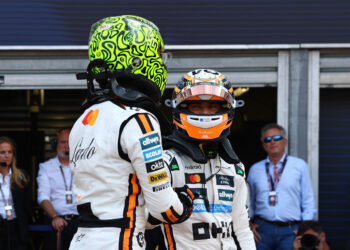For years, Andretti Global’s ambition to enter Formula 1 felt like a dream perpetually stuck in neutral. Despite iconic branding and American motorsport pedigree, its January 2024 rejection by F1—citing a grid already full at 10 teams—left many feeling the door was firmly shut. Fast-forward to today, and the narrative has flipped: General Motors, leveraging its Cadillac brand, is now poised to drive Andretti into F1 as a legitimate powerhouse. But the journey has been anything but smooth, and, even now, the road ahead is littered with mixed signals.
The Initial Rejection: A Bump in the Road
When Andretti’s 2026 entry was declined earlier this year, insiders weren’t shocked. F1’s leadership, helmed by Stefano Domenicali, had long signaled reluctance to expand beyond 10 teams despite the appeal of Andretti’s proposal. Even the involvement of General Motors—a name that turns heads globally—wasn’t enough to seal the deal initially.
Critics, including teams like Williams, cast doubt on GM’s commitment. Was Cadillac’s role genuine or a mere re-badging exercise? Furthermore, Andretti’s reliance on Renault engines—amid whispers of the French manufacturer’s waning commitment to F1—raised concerns about long-term stability.
From Doubt to Clout: The Cadillac Comeback
Now, in a dramatic turnaround, GM’s Cadillac entry has gained traction with F1, thanks largely to enhanced assurances. GM’s active development of its own power unit for the 2028 season has elevated its bid from “team sponsor” to “team manufacturer.” This commitment silences skepticism about Cadillac being a marketing exercise, solidifying its value as a legitimate addition to F1’s ecosystem.
Andretti’s Internal Shakeup: A Necessary Pivot
While the technical backbone of the Andretti bid remains unchanged, significant leadership shifts have occurred. Michael Andretti—once the project’s public face—has stepped aside, with financier Dan Towriss now overseeing operations. Insiders insist this move wasn’t due to personal friction but to streamline decision-making. Towriss, alongside major investor Mark Walter, has brought the financial and managerial muscle necessary to convince F1.
Still Waiting in the Wings
Despite public enthusiasm, the Cadillac team remains in limbo. The FIA must formally grant its entry, and until then, Cadillac lacks access to critical resources like Pirelli tire data and open-source technical materials. F1’s reluctance to finalize the deal reflects lingering logistical and anti-dilution fee negotiations, leaving the team stuck in an awkward holding pattern.
A Mixed Message from F1
This saga highlights F1’s delicate balancing act. While Cadillac’s global clout bolsters F1’s burgeoning American fanbase, the hesitation to expand beyond 10 teams underscores the sport’s resistance to change. The involvement of the U.S. Department of Justice, investigating potential anti-competitive practices, may have nudged F1 toward approval—but the series’ careful handling of anti-dilution fees signals ongoing caution.
What’s Next?
For Cadillac, the path to 2026 is clearer than ever, but hurdles remain. The transition from “potential entrant” to “full-fledged competitor” requires formal FIA approval—a move expected soon but not guaranteed. Meanwhile, the team must prepare to meet the sport’s demanding standards while fending off any remaining doubts.
The Final Lap
Andretti and Cadillac’s F1 journey has been fraught with skepticism, corporate reshuffles, and regulatory hurdles. But with F1’s no-turning-back announcement, the message is clear: the grid is set to expand, and the world’s biggest automaker will soon take its place. Yet, the mixed signals remind us that in Formula 1, the race isn’t over until the checkered flag waves.










